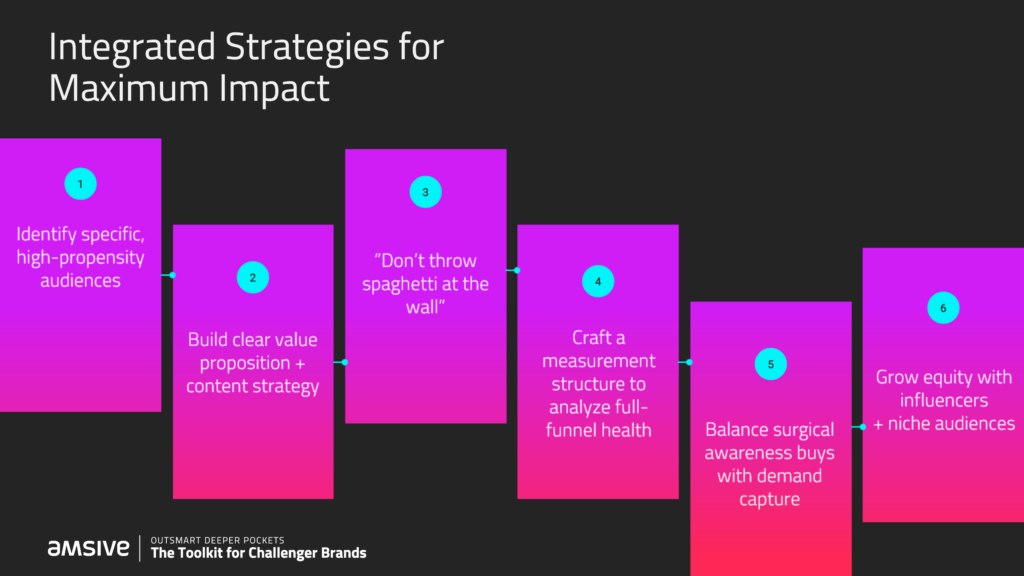Challenger brands face unique challenges as they work to carve out a niche against established brands. While the allure of short-term sales can be tempting, a singular focus on immediate wins can undermine long-term brand positioning.
Explore the common pitfalls of short-term thinking, discover the significance of a holistic digital marketing strategy, and learn effective methods for integrating paid and organic approaches to enhance visibility and foster loyalty. By adopting a strategic mindset, challenger brands can ensure sustainable growth while remaining true to their core values.
Jump To:
The danger of short-term thinking
A heavy focus on immediate sales is a common pitfall for challenger brands. By prioritizing short-term sales, you risk undermining your brand positioning among larger players in the field. Having an emphasis on quick gains, or short-termism, can generate quick revenue and dilute brand value. Challenger brands thrive on authenticity and genuine connection. Sacrificing these qualities for short-term gains can alienate your core audience.

Without long-term brand building efforts, challenger brands face the dangers of lower brand recognition among their target audience. This makes it less likely that your ideal customer will search for your brand when they’re ready to make a purchase.
Key takeaway: Prioritizing immediate sales can undermine brand authenticity and recognition, leading to diminished customer loyalty and weaker brand positioning in the market.
Maintaining brand integrity while driving sales
Balancing immediate sales with your brand equity is crucial for effective brand building. While it’s important to target consumers that are already aware of your brand and are ready to make a purchase, it’s equally essential to building broader brand recognition. In paid media, the focus often shifts to capturing high-intent users that are actively searching for your brand. That said, if brands are not actively promoting themselves, a consumer will not seek them out when they’re moving to the conversion stage. Brands must actively promote themselves and increase visibility to encourage greater consideration.
Challenger brands need to implement strategies that will resonate with both existing and new audiences. This means carefully managing awareness campaigns to avoid the short-termism as a common stumbling block for challenger brands. Because of this, it’s essential to strike a balance between meeting your customer’s needs while building awareness through holistic marketing strategies.
Key takeaway: Balancing short-term sales efforts with long-term brand equity is crucial; brands should actively promote themselves to ensure visibility and awareness among target audiences.
The importance of a holistic digital marketing strategy
Pinpointing the right channels to guide your customers from awareness to conversion can be difficult. This can be further aggravated by the fact that marketers are increasingly challenged to outperform previous results while working with tighter budgets.
A holistic strategy can supercharge the impact with an integrated approach. This approach also helps to build consistency across digital channels by creating a unified brand voice. This helps boost brand recognition and trust among your ideal audience, when competing against larger, more established players.
As consumers are bombarded with options, a holistic digital marketing strategy equips challenger brands to effectively communicate their unique value propositions, ultimately driving growth and fostering loyalty.

Key takeaway: An integrated digital marketing approach enhances brand consistency and trust, allowing challenger brands to effectively communicate their unique value propositions.
Integrating paid and organic strategies for audience engagement
Blending organic and paid marketing is essential for challenger brands as they build their visibility in a competitive landscape. While paid media offers immediate access to targeted audiences that are ready to convert, organic strategies can build lasting brand awareness. This approach allows brands to engage with consumers across their purchasing journey.
It’s important for organic search to reach high intent users early. It’s important to signal to search algorithms that your site is directly connected to what people are searching for, and that your site offers users a good experience. When you’ve reached target, high intent users that spend increased time on site, Google registers those engagements and increases the likelihood of having traffic sent traffic your way. These interactions can help you climb in the search rankings and earn organic impressions.
You can also use paid search data to refine your organic search content, focusing on high-converting keywords and topics. Implementing consistent messaging across both search experiences can build a cohesive user experience. Conversely, leveraging retargeting campaigns in your paid search efforts can help you reconnect with users that previously interacted with your site.
Measuring the impact of your integrated paid and organic search strategies will help you gain a clearer picture of where those methods still need improvement. Overall, remember that as you improve your organic visibility, your long-term ROI will improve. You’ll decrease the total cost of your marketing efforts, and make improve your acquisition, retention, and brand recall efforts.
Key takeaway: Combining paid and organic marketing efforts maximizes visibility and engagement, allowing brands to reach consumers throughout their purchasing journey.
Prioritizing data collection and informed decision making
As with your paid and organic search strategies, it’s important for marketers to consistently collect data and use it to inform their strategy. It can be tempting in certain channels to have a ‘set and forget’ mentality, but this approach can lead to inefficient spend and ineffective targeting in the long run.
By analyzing your ideal consumer’s behavior, market trends, and the overall competitive landscape, challenger brand have the opportunity to fill gaps in the market with their USP. Actionable, data-driven insights can foster a nimble approach to marketing, allowing you to stay ahead of the competition and adapt to shifting consumer preferences. Leveraging data-led insights can help build stronger connections with target audience, driving engagement and fostering a sense of loyalty.
“It’s super important for search and particularly organic search to really hit those high intent users in the beginning, because what you’re effectively doing is training…the search algorithms that your site is very directly connected to the thing that people are searching for.” – Joshua Squires
Challenger brands can also use their pools of data to continually learn and optimize campaigns in real-time. This allows for precise targeting, leading to increasingly efficient budget allocation.
Another common pitfall of challenger brands, especially when bandwidth is low, is that time is often of the essence. Building trust in an algorithm-driven campaign, such as Google’s Performance Max campaigns, requires a strong emphasis on data transparency and performance tracking. You have to balance real-time optimization with allowing your algorithms to get enough data to make decisions.
When marketers can trust certain campaigns to run in the background, they’re able to then focus on building awareness, equity, and brand growth, leveraging data to refine messaging and enhance customer experiences while maximizing ROI.
Key takeaway: Consistent data collection and analysis are essential for refining marketing strategies and fostering connections with target audiences, leading to more efficient budget allocation.
Strategies for awareness, equity, and brand growth
Audience insights are crucial to build awareness and growth across the digital space. When we think historically about awareness buys, they were often broad buys with looser demographic targeting. For example, think of billboards on the side of the highway, or television capturing somebody watching a live sporting event or the local news on any given night.
These days, it is of the utmost importance to be surgically precise with audience targeting when you’re planning awareness buys—especially for challenger brands. In practice, this can look like an audience-first approach on a CTV buy, allowing you to reach a very specific audience wherever they’re consuming content on connected television.
“Carving out a specific testing budget and aligning on a KPI for that is so huge. That way we don’t launch a massive CTV buy targeting our varied niche specific audiences and expect them to perform exactly the way branded search would, or launching an organic social buy that’s maybe meant to drive a little bit more brand equity.” – Laurin Bobo
This is also applicable int he case of channels like streaming radio, reaching your ideal audience rather than advertising on a local channel, which would play your message to anyone who may be listening at the time.
You can reach your target audience wherever they’re consuming content to still hit those awareness impressions—without facing the same amount of wasted impressions that broad awareness buys can lead to.
Key takeaway: Precise audience targeting in awareness campaigns is vital for challenger brands to effectively reach their ideal customers without wasting impressions.
Building awareness on social
Building awareness organically through social media is also going to have an impact on your overall SEO and EEAT ranking. Working with thought leaders or influencers on behalf of a brand can help you to reach target audiences that are typically outside of your reach. It can also help you tap into authentic conversations while building awareness.
As with your search strategy, it’s critical that your messaging aligns with other channels and points in the funnel. With every company and competitor chasing the same recent impressions, you can’t rely on a single tactic, channel, or platform to fill in the gaps.
Social is also an excellent channel to tap into for a greater understanding of your audience. The rise of Reddit as an SEO juggernaut may be a more recent development, but it has been a treasure trove of consumer sentiment for a long time. With consumer sentiment shifting constantly, it’s important to monitor these conversations where they naturally happen, as they happen. Forum-based platforms like Reddit can provide a window into broader consumer sentiment, offering insight into pain points, experiences, and solutions that your ideal customer may experience with your or a competitor’s brand.
“The intersection of those things and how do we then maybe listen in on those conversations that people are having to, again, be able to more quickly, identify real time pain points that the consumer is having using tools like social listening as well as manual or just being present on the platforms.” – Chalice Jones
Organically digging into these conversations offers brands a cost-effective way of improving messaging, channel use, and budget allocation.
Key takeaway: Leveraging social media and engaging with influencers can enhance brand visibility and SEO, while monitoring consumer sentiment on platforms like Reddit provides valuable insights.
Holistically measuring your success
While it’s important to measure and monitor success by platform, you have to remember that there’s a certain amount of platform handoff. A consumer may start their journey on social, or search, or in their inbox, but that will often lead them to a website or brick and mortar location, where they ultimately complete their conversion.
Larger companies often face internal segmentation, and marketing channels operate in silos with ineffective communication. This disconnect makes it difficult to track the complete user journey and prove out ROI. Challenger brands that establish a habit of holistic measurement from the start can gain valuable insights and continuously iterate their strategies, allowing them to optimize performance quickly.
Following the full user journey, tracing it end to end and digging down to the inefficiencies can help improve budget allocation and channel use to accurately prove out your ROI. To effectively measure ROI across all channels, including organic efforts, companies should prioritize smart website architecture that aligns with their primary KPIs. This involves breaking down user interactions by categories and subcategories to understand behavior across different site sections.

Additionally, aligning marketing strategies across the entire ecosystem allows brands to address the full user journey from awareness to retention. By streamlining KPIs and measurement, brands can focus on recognizing their marketing efforts as intentional, strategic distribution channels.
Key takeaway: Tracking the entire customer journey across multiple platforms allows brands to optimize performance and accurately measure ROI, addressing inefficiencies in budget allocation.
Navigate the short- and long-term goals with ease
Ultimately challenger brands must navigate the delicate balance between short-term sales goals and long-term brand equity. While immediate gains can be tempting, sacrificing brand authenticity and integrity for quick wins can lead to diminished recognition and loyalty among target audiences.

By prioritizing holistic marketing strategies that integrate both paid and organic approaches, these brands can foster genuine connections with consumers, ensuring that their messaging resonates throughout the purchasing journey. Committing to a comprehensive, audience-first strategy helps challenger brands set themselves for sustainable growth and cultivate the trust and loyalty needed to compete with larger players in the market.
Are you trying to outsmart deeper pockets as a challenger brand? Explore more tactics to disrupt market leaders in our latest webinar, or let’s talk about how to achieve more for your marketing—and your business.






